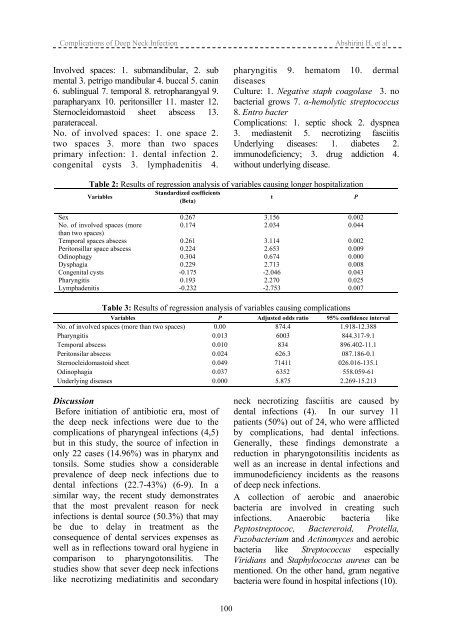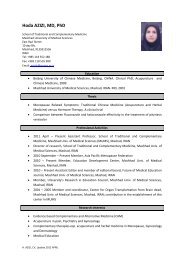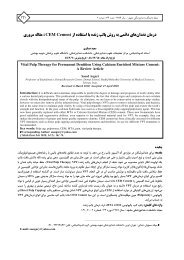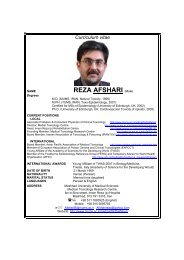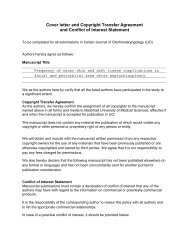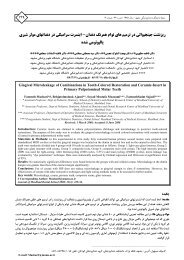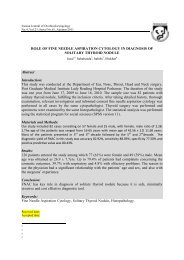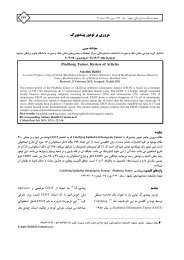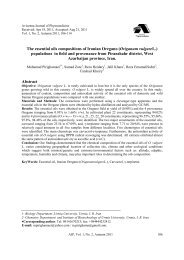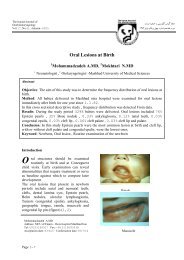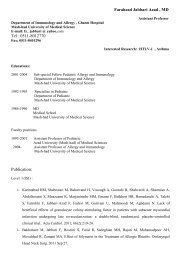Predisposing Factors for the Complications of Deep Neck Infection
Predisposing Factors for the Complications of Deep Neck Infection
Predisposing Factors for the Complications of Deep Neck Infection
You also want an ePaper? Increase the reach of your titles
YUMPU automatically turns print PDFs into web optimized ePapers that Google loves.
<strong>Complications</strong> <strong>of</strong> <strong>Deep</strong> <strong>Neck</strong> <strong>Infection</strong> Abshirini H, et al<br />
Involved spaces: 1. submandibular, 2. sub<br />
mental 3. petrigo mandibular 4. buccal 5. canin<br />
6. sublingual 7. temporal 8. retropharangyal 9.<br />
parapharyanx 10. peritonsiller 11. master 12.<br />
Sternocleidomastoid sheet abscess 13.<br />
parateraceal.<br />
No. <strong>of</strong> involved spaces: 1. one space 2.<br />
two spaces 3. more than two spaces<br />
primary infection: 1. dental infection 2.<br />
congenital cysts 3. lymphadenitis 4.<br />
100<br />
pharyngitis 9. hematom 10. dermal<br />
diseases<br />
Culture: 1. Negative staph coagolase 3. no<br />
bacterial grows 7. α-hemolytic streptococcus<br />
8. Entro bacter<br />
<strong>Complications</strong>: 1. septic shock 2. dyspnea<br />
3. mediastenit 5. necrotizing fasciitis<br />
Underlying diseases: 1. diabetes 2.<br />
immunodeficiency; 3. drug addiction 4.<br />
without underlying disease.<br />
Table 2: Results <strong>of</strong> regression analysis <strong>of</strong> variables causing longer hospitalization<br />
Variables<br />
Sex<br />
No. <strong>of</strong> involved spaces (more<br />
than two spaces)<br />
Temporal spaces abscess<br />
Peritonsillar space abscess<br />
Odinophagy<br />
Dysphagia<br />
Congenital cysts<br />
Pharyngitis<br />
Lymphadenitis<br />
Standardized coefficients<br />
(Beta)<br />
0.267<br />
0.174<br />
0.261<br />
0.224<br />
0.304<br />
0.229<br />
-0.175<br />
0.193<br />
-0.232<br />
t<br />
3.156<br />
2.034<br />
3.114<br />
2.653<br />
0.674<br />
2.713<br />
-2.046<br />
2.270<br />
-2.753<br />
Table 3: Results <strong>of</strong> regression analysis <strong>of</strong> variables causing complications<br />
Variables<br />
No. <strong>of</strong> involved spaces (more than two spaces)<br />
Pharyngitis<br />
Temporal abscess<br />
Peritonsilar abscess<br />
Sternocleidomastoid sheet<br />
Odinophagia<br />
Underlying diseases<br />
P<br />
0.00<br />
0.013<br />
0.010<br />
0.024<br />
0.049<br />
0.037<br />
0.000<br />
Discussion<br />
Be<strong>for</strong>e initiation <strong>of</strong> antibiotic era, most <strong>of</strong><br />
<strong>the</strong> deep neck infections were due to <strong>the</strong><br />
complications <strong>of</strong> pharyngeal infections (4,5)<br />
but in this study, <strong>the</strong> source <strong>of</strong> infection in<br />
only 22 cases (14.96%) was in pharynx and<br />
tonsils. Some studies show a considerable<br />
prevalence <strong>of</strong> deep neck infections due to<br />
dental infections (22.7-43%) (6-9). In a<br />
similar way, <strong>the</strong> recent study demonstrates<br />
that <strong>the</strong> most prevalent reason <strong>for</strong> neck<br />
infections is dental source (50.3%) that may<br />
be due to delay in treatment as <strong>the</strong><br />
consequence <strong>of</strong> dental services expenses as<br />
well as in reflections toward oral hygiene in<br />
comparison to pharyngotonsilitis. The<br />
studies show that sever deep neck infections<br />
like necrotizing mediatinitis and secondary<br />
Adjusted odds ratio<br />
874.4<br />
6003<br />
834<br />
626.3<br />
71411<br />
6352<br />
5.875<br />
P<br />
0.002<br />
0.044<br />
0.002<br />
0.009<br />
0.000<br />
0.008<br />
0.043<br />
0.025<br />
0.007<br />
95% confidence interval<br />
1.918-12.388<br />
844.317-9.1<br />
896.402-11.1<br />
087.186-0.1<br />
026.016-135.1<br />
558.059-61<br />
2.269-15.213<br />
neck necrotizing fasciitis are caused by<br />
dental infections (4). In our survey 11<br />
patients (50%) out <strong>of</strong> 24, who were afflicted<br />
by complications, had dental infections.<br />
Generally, <strong>the</strong>se findings demonstrate a<br />
reduction in pharyngotonsilitis incidents as<br />
well as an increase in dental infections and<br />
immunodeficiency incidents as <strong>the</strong> reasons<br />
<strong>of</strong> deep neck infections.<br />
A collection <strong>of</strong> aerobic and anaerobic<br />
bacteria are involved in creating such<br />
infections. Anaerobic bacteria like<br />
Peptostreptococ, Bactereroid, Protella,<br />
Fuzobacterium and Actinomyces and aerobic<br />
bacteria like Streptococcus especially<br />
Viridians and Staphylococcus aureus can be<br />
mentioned. On <strong>the</strong> o<strong>the</strong>r hand, gram negative<br />
bacteria were found in hospital infections (10).


